I was reading thisuy one yesterday... Did you norptice the repeated image? He posted the same tree twice- pic 10 I think and the next to last tree pic in the article looks to be the same pic... It stood out to me because I have been focusing on pots more lately and the pot that one is in was one of the most interesting and dynamic pots in that group of pics I thought! A beautiful pot... But perhaps it stands out too much I noticed it as much as I did...
Personally I know practically nothing about matching trees and pots, and only recently started to get into pots much at all... I find myself drawn to colorful, flashy ones by themselves, but on trees... I like the unglazed or muted colored pots better almost every time. A light green, cream or a blue that isn't all shiny and new looking fits better on a wider range of trees than one of those wild multi- colored glazes with drippy tie-die looking swirls... A regular old brown unglazed can fit just about any tree, especially any Juniper or pine, and will look better than some eye catching crazy rainbow colored pot! So... I bought a bunch of used unglazed Well- made Japanese pots from a local guy recently. I got a few more flashy ones too... But my goal when buying pots is to use them more as the gram Adair was talking about than the Jewelry our ladies with "Cadillac Tastes" may prefer!

.
I guess "utilitarian" would be my style when it comes to pots. I WANT TO BUY all the cool looking ones, but I know I will probably never use them.
Aside- Someone here recently commented in a thread about American potters that they do not make good rectangles... After really looking at a wide range of American made pots, I realized the truth in that comment. The angular, refined antique Japanese pots... The old wedge shaped ones with the windows and the ones with the smoother more rounded lines that are simple elegant, fade to lighter colors in the middle.. There is just nothing like that being made by American potters! Maybe it shows a progression, or a mindset that American potters are artists not craftsmen... But to me, I feel like maybe they would learn a lot and improve a lot if they perfect the classic Bonsai pot first, before moving on to the "artsy" stuff! JMHO. Gorgeous stuff being made in America... Lots of beautiful ART being made by American potters.. I just don't know if I want to plant trees in some of them. I am sure it is possible I "just don't get it" or don't have the trees to over power those pots. Just saying what I feel.



